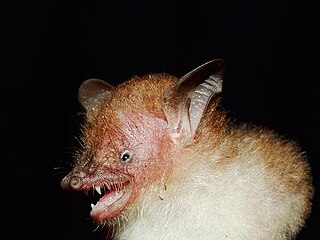
Andersen's fruit-eating bat is a bat species found in South America.

Hodgson's bat, also called the copper-winged bat or black-and-orange myotis, is a species of vesper bat in the genus Myotis, the mouse-eared bats. Favouring mountain forests, it is found throughout Central, Southeast, and East Asia, from Afghanistan to Taiwan. It is about 5 centimetres (2.0 in) long and is distinguished from most other species of bat in this range by its yellowish colouration.

Murina is a genus of vesper bats. They are found throughout temperate and tropical regions of Asia.

Allen's big-eared bat is a species of vesper bat in the monotypic genus Idionycteris. It occurs in Mexico and in Arizona, California, Nevada, New Mexico, Utah, and Colorado in the United States.

The Oldfield white-bellied rat or soft-furred Taiwan niviventer is a species of phat rat in the family Muridae. It is found only in Taiwan. It has also been considered a subspecies of Niviventer niviventer and included in Niviventer confucianus.
The gland-tailed free-tailed bat is a species of bat in the family Molossidae. Its natural habitats are subtropical or tropical moist montane forests, dry savanna, and caves.

The São Tomé free-tailed bat is a species of bat in the family Molossidae. It is endemic to São Tomé and Príncipe. Its natural habitats are dry savanna, moist savanna, and plantations. It is threatened by habitat loss. Only three individuals have ever been documented.

The Khajuria's leaf-nosed bat, also known as Durga Das's leaf-nosed bat, is a species of bat in the family Hipposideridae. It is endemic to India. Its natural habitat is caves. It is threatened by habitat loss.

The Kolar leaf-nosed bat, or leafletted leaf-nosed bat is a species of bat in the family Hipposideridae. It is endemic to India. Its natural habitats are subtropical or tropical dry forests and caves. It is found in only one cave in India, and its population is less than 200 individuals.

Jones's roundleaf bat is a species of bat in the family Hipposideridae. It is endemic to southern West Africa. Its natural habitats are subtropical or tropical dry forest, savanna, subtropical or tropical dry lowland grassland, rocky areas, and caves and other subterranean habitats.

The Jamaican flower bat is a critically endangered species of bat in the family Phyllostomidae. It is endemic to Jamaica.

The lesser yellow-shouldered bat is a species of bat in the family Phyllostomidae. It is native to Peru and Ecuador. It is threatened by habitat loss.

Fea's tube-nosed bat, also known as the ashy tube-nosed bat, is a species in the vesper bat in the family Vespertilionidae, found in southeastern Asia and southern China. They have tube-shaped nostrils which assist them with their feeding. It is named after Italian naturalist Leonardo Fea.

Walston's tube-nosed bat is a species in the vesper bat family Vespertilionidae, found in the Greater Mekong region of Southeast Asia, specifically the Đắk Lắk Province of Vietnam and the Koh Kong and Ratanakiri provinces of Cambodia. This species was discovered in northeastern Cambodia in the Van Sai Protected Forest. They have tube-shaped nostrils which assist them with their feeding.
The slender tube-nosed bat is a species of vesper bat in the family Vespertilionidae found only in Taiwan.
The Formosan golden tube-nosed bat is native to the high-altitude regions of Taiwan.

The Bala tube-nosed bat is a critically endangered species of bat found in Thailand.

Ejeta's yellow bat or Ejeta's house bat is a species of vesper bat endemic to in Ethiopia. It was described as a new species of bat in 2014.
The hidden tube-nosed bat is a species of bat found in Taiwan.















